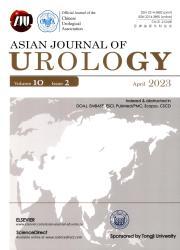Robot-assisted partial nephrectomy for renal cell carcinoma: A narrative review of different clinical scenarios
IF 2.4
3区 医学
Q2 UROLOGY & NEPHROLOGY
引用次数: 0
Abstract
Objective
Nowadays robot-assisted partial nephrectomy (RAPN) represents the standard of care for clinical T1 (cT1) renal masses, providing similar oncological outcomes when compared to open or laparoscopic PN with advantages in terms of functional outcomes and lower perioperative comorbidity, when compared to radical nephrectomy.
Methods
We performed an extensive literature review of studies regarding RAPN, its evolution, technical aspects and applications, and new technological tools using different combinations of Medical Subject Headings terms “RAPN”, “partial nephrectomy”, “robot-assisted”, “nephron-sparing surgery”, “renal cell carcinoma”, “complex renal masses”, “endophytic renal masses”, and “bilateral renal tumors”.
Results
A consistent body of evidence was selected, including original articles, systematic reviews, meta-analyses, and clinical trials having RAPN as the central focus in adult patients, with all its technical nuances. We started our narrative review with a background on PN and its evolution toward the robotic era with a special spotlight on the extending indications for PN in large and highly complex renal masses. Our review continued with an overview of nephron-sparing surgery in bilateral and recurrent masses. RAPN for bilateral synchronous renal masses represents a challenging scenario with no formal recommendations provided by international guidelines and controversial management and decision-making. Additionally, we reported evidence on redo RAPN which seems to be safe and effective. A final overview of the available technological tools, and in particular on three-dimensional reconstruction was provided.
Conclusion
RAPN has been established as the standard of care for cT1 renal masses with an expanding spectrum of applications in different scenarios, including large (cT2), highly complex, and bilateral renal masses, as well as the surgical treatment of local recurrences after nephron-sparing surgery with acknowledged advantages in terms of functional outcomes and perioperative risk profiles while maintaining similar oncological outcomes when compared to open or laparoscopic PN and radical treatment.
机器人辅助部分肾切除术治疗肾细胞癌:不同临床情况的叙述回顾
目前,机器人辅助部分肾切除术(RAPN)是临床T1 (cT1)肾肿块的标准治疗方法,与开放式或腹腔镜下的肾切除术相比,它提供了相似的肿瘤结果,与根治性肾切除术相比,在功能结果和更低的围手术期合并症方面具有优势。方法采用医学主题词“RAPN”、“部分肾切除术”、“机器人辅助”、“肾保留手术”、“肾细胞癌”、“复杂肾肿块”、“内生肾肿块”和“双侧肾肿瘤”的不同组合,对RAPN的发展、技术方面和应用以及新技术工具的研究进行了广泛的文献综述。结果选择了一致的证据,包括原始文章、系统综述、荟萃分析和以RAPN为中心的成人患者临床试验,以及所有技术上的细微差别。我们从PN的背景及其向机器人时代的演变开始我们的叙述性回顾,特别关注PN在大型和高度复杂的肾脏肿块中的扩展适应症。我们继续回顾双侧和复发性肿瘤中保留肾单元的手术。双侧同步性肾肿块的RAPN是一个具有挑战性的方案,国际指南没有提供正式的建议,管理和决策也存在争议。此外,我们报告了重做RAPN的证据,它似乎是安全有效的。最后概述了现有的技术工具,特别是三维重建技术。结论rapn已成为cT1肾肿物的标准治疗方法,在不同情况下的应用范围不断扩大,包括大型(cT2)、高度复杂和双侧肾肿物。以及保留肾元手术后局部复发的手术治疗,与开放或腹腔镜PN和根治性治疗相比,在功能结局和围手术期风险方面具有公认的优势,同时保持相似的肿瘤预后。
本文章由计算机程序翻译,如有差异,请以英文原文为准。
求助全文
约1分钟内获得全文
求助全文
来源期刊

Asian Journal of Urology
UROLOGY & NEPHROLOGY-
CiteScore
4.00
自引率
3.80%
发文量
100
审稿时长
4 weeks
期刊介绍:
Asian Journal of Urology (AJUR), launched in October 2014, is an international peer-reviewed Open Access journal jointly founded by Shanghai Association for Science and Technology (SAST) and Second Military Medical University (SMMU). AJUR aims to build a communication platform for international researchers to effectively share scholarly achievements. It focuses on all specialties of urology both scientifically and clinically, with article types widely covering editorials, opinions, perspectives, reviews and mini-reviews, original articles, cases reports, rapid communications, and letters, etc. Fields of particular interest to the journal including, but not limited to: • Surgical oncology • Endourology • Calculi • Female urology • Erectile dysfunction • Infertility • Pediatric urology • Renal transplantation • Reconstructive surgery • Radiology • Pathology • Neurourology.
 求助内容:
求助内容: 应助结果提醒方式:
应助结果提醒方式:


